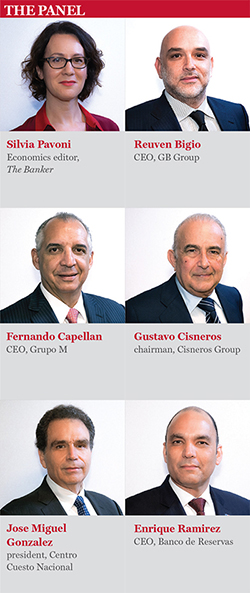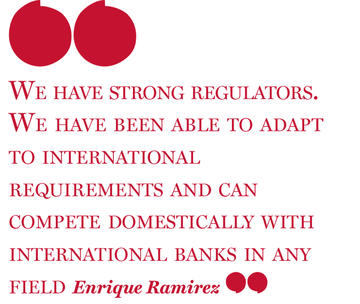The Dominican Republic is unquestionably the current economic star of Latin America in terms of growth. It has a thriving tourism industry, which it is now attempting to diversify, and a revitalised mining industry. The economy is supported by a healthy banking sector and robust levels of foreign direct investment. That means it can afford to implement a social policy aimed at dramatically raising levels of education and health coverage.
Last year, the Dominican Republic recorded a 7% increase in gross domestic product (GDP), according to projections by the UN Economic Commission for Latin America and the Caribbean. That was the highest economic growth in Latin America by some margin, ahead of next-best Panama at 5.9% and Bolivia at 4.5%. Inflation remained subdued, at a little over 2%, while foreign reserves rose by 8% to $5.27bn. Public sector balances remained relatively healthy, with debt at a respectable 45% of GDP.
On the back of this impressive performance, the Dominican Republic has been able to keep its budget deficits in check by making repeat visits to the international bond market. Here, investors have had the confidence to buy longer dated issues than is usual from a developing economy. The sovereign raised $2.5bn 2015, including $1.5bn in 30-year paper. It had already sold $1.25bn in 30-year bonds during 2014, and returned to the international markets in January 2016 to sell $1bn of bonds maturing in 2026.
Tourism strength
The Dominican Republic has a diverse economy. While it is a long-standing exporter of sugar, coffee and tobacco, agriculture has been overtaken by services as the most important economic contributor. Free-trade zones are expanding, with products as varied as textiles, shoes, jewellery, medical devices and cigars, and telecommunications is enjoying growth. But the most vibrant industry is tourism.
Nearly 6 million foreign holidaymakers visit the country each year, many of them from the nearby US. (The economy is highly dependent on the US which, as well as supplying two-thirds of tourism revenues, buys about half of Dominican exports. Remittances from Dominicans working in the US are equivalent to roughly one-third of exports.)
The current plan, being worked on by both the government and the private sector, is to grow annual tourist numbers to 10 million by 2020. The Dominican Republic gets more visitors than any other Caribbean country and, in Latin America as a whole, has ranked second only to Brazil in tourist income. "This year we expect to lead Brazil in terms of income," says Enrique Ramirez, CEO of Banco de Reservas.
Dominican Republic president Danilo Medina has been keen to promote ecological tourism and to develop the luxury end of the market, diversifying tourism in a way that helps to develop other small businesses. Leading the way is the development of a five-star Four Seasons hotel in the Tropicalia resort, which lies in the hitherto underdeveloped Miches area in the north of the island.
Both the hotel project and the Tropicalia development are being undertaken by the Cisneros Group, an international media and property empire with Venezuelan roots. Until now, the Dominican tourism industry has been mostly four-star and all-inclusive. But Cisneros Group’s chairman, Gustavo Cisneros, who is now a Dominican citizen, says that the Four Seasons project sends out a message that the Dominican Republic will become a "highly luxurious" destination.
High-end target
"Why is that important?" says Mr Cisneros. "Because five-star developments give much more money to the community – with the all-inclusive system, it stays very much with the operators." Tropicalia can accommodate up to 10 luxury hotels, and Mr Cisneros hopes that other Spanish and American operators in the country will now upgrade their four-star hotels to five-star status.
"We have a great opportunity now," adds Mr Cisneros. "We have a president who wants to do it, we have the banks who want to finance it and we have the tourists that want to come. The Chinese market alone is gigantic and they have lots of money, so the time is now."
Mr Cisneros is keenly aware that the Cuban tourist trade is opening up and that Cuba will be opening luxury hotels very quickly. "The Cubans want to change their tourism sector to high end," he says. "But we have the advantage right now, so we have to take care of it."
Dominican tourism is attracting international attention on a number of different levels. Vinci, a French airport operator, recently acquired Aerodom, a Dominican company with a concession to run six of the nine local airports. The concession runs until 2030.
"Vinci is very experienced in the airport business," says Jose Miguel Gonzalez, president of Dominican retail group Centro Cuesto Nacional. "And it is coming to the Dominican Republic because of the future it sees in tourism here. It will upgrade and invest in the airports and bring even more tourists to the Dominican Republic."
Cruise control
Carnival Cruise Lines recently opened its Amber Cove port in the north of the Dominican Republic, even as other cruise companies are making more calls at the country's ports. "With Carnival coming into the Dominican Republic, we now know about other cruise ship companies that are interested in building two more ports in the north part of the country," says Mr Gonzalez.
This kind of tourism is also different to the all-inclusive variety, because the visitors are more likely to travel around the island and interact with the community. "They tend to explore different attractions and visit the towns," says Mr Gonzalez.
When it comes to cruise holidays, neighbouring Cuba could be an ally rather than a competitor. "I think that with Cuba opening up, this can help us to attract even more cruise ships," says Mr Gonzalez. "Because we are so close together, the ships can include both islands on their itineraries."
While tourism provides employment, it also generates domestic consumption, to the benefit of agriculture and manufacturing in the Dominican Republic. "We are not only producing for 10 million Dominicans, but we also produce for almost 10 million Haitians and nearly 6 million tourists," says Mr Ramirez. "So we have the capacity to produce for 25 million people every year. That's a key to our economic success."
Ripple effect
The effects of a successful tourism industry ripple out into other parts of the Dominican Republic economy, in the shape of infrastructure projects and commercial opportunities. A new 72-kilometre highway connecting Punta Cana airport and the Miches region was recently opened. Punta Cana airport itself ("the best airport in the Caribbean", according to Mr Cisneros) continues to expand, and has plans to open a US border preclearance facility. That would confer a competitive tourism advantage over Cuba, which is unlikely to benefit from such a facility for some time to come, according to Mr Cisneros.
Haiti-based GB Group is one of the Caribbean's largest privately owned industrial groups, operational in sectors including oil, telecoms and construction businesses. It has become the largest provider of aviation fuel in the region. "One of the reasons for that is Punta Cana airport, which is the second largest in the region," says Reuven Bigio, GB Group's CEO. "That has enabled [us] to expand as an operator in other Caribbean islands, where we can then contribute expertise in the supply of fuel."
The local textiles industry is a shadow of its former self, however, since the final phasing out in 2005 of the Multi-Fibre Arrangement, which protected it from Asian competition. However, while there are signs that business lost to Asia may be coming back, Dominican companies can take advantage of certain trade benefits enjoyed by neighbouring Haiti.
Under US legislation, including the Hope and Help Acts, Haiti enjoys duty-free access to the US market for textiles and apparel. Grupo M, a Dominican Republic-based vertically integrated textile company, makes garments across the border in Haiti, in the Codevi industrial park, which it also owns. "For every three jobs we create in Haiti, we create 1.5 jobs in the Dominican Republic on the textile side, and on finishing, designing and merchandising," says Fernando Capellan, CEO of Grupo M.
Together with the duty-free benefits of the Economic Partnership Agreement with the EU, least developed country preferences from Canada and the Central America Free Trade Agreement, this is a winning combination for all light manufacturing, according to Mr Capellan. "I think this is an incentive and an opportunity for companies around the world looking for where to place their production," Mr Capellan said. "There's no better combination in this part of the world than the Dominican Republic and Haiti for line manufacturing."
Mining is another important sector in the Dominican Republic, which adds to economic strength through diversity, most notably at the Pueblo Viejo gold mine. Situated on one of the largest gold deposits in the world, this is a recent redevelopment of an existing mine and is 60:40 owned by Canada's Barrick Gold and Goldcorp. Pueblo Viejo was financed entirely by foreign banks, because it was feared that such a big project could not be handled locally. Nonetheless, the Dominican Republic has one of the healthiest financial sectors in the Caribbean, with the capacity to support the country's needs, according to Mr Ramirez. "We have strong regulators," he says. "We have been able to adapt to international requirements and can compete domestically with international banks in any field. And we are ready to support the different areas that have been identified as key growth factors for the Dominican Republic."
Financial strength
BanReservas is a state-owned commercial bank and, when Mr Medina took office in 2012, its loan portfolio was split 70:30 between government and the private sector. "Today it's the opposite, with more than 70% going to the private sector," says Mr Ramirez. "We have been able to support construction, affordable housing, commercial loans and the tourism industry."
The bank is strong on financial inclusion, aware of its social responsibility and the fact that many of the country's people are not financially educated. "So we will invest money and effort into educating our clients and generating more financial inclusion," says Mr Ramirez.
Mr Capellan acknowledges that support from local banks is definitely there, complemented by the rising level of confidence in the Dominican Republic being demonstrated by the presence of international banks. That is important in an industry where manufacturers have to move ever faster to react to market demands, he says.
One of the Dominican Republic's more notable features, according to Mr Cisneros, is that foreign banks are able to operate in the country on an equal basis. And he believes, more specifically, that local banks should get more involved in the mining sector. If banks such as BanReservas got to know the Dominican mining industry, he argues, they could take advantage of lending opportunities in Haiti, which has the same geology, and parts of Latin America, such as Colombia, Venezuela and Panama, where there is a lot of mining activity.
A learning curve
If children represent a country's future, then the Dominican Republic has the future firmly in its sights. Having historically had a reputation for one of the world's worst education systems, it now plans to double the number of classrooms in the next four years and is allocating 4% of its GDP to education. Recent reforms have included prolonging the school day and giving children free school meals. This has increased attendance levels and helped to reduce youth crime.
"Student meals and longer school hours have a positive impact on family economies, because very poor families are not spending money on breakfast and lunch," says Mr Gonzalez. "And mothers have the opportunity to look for work while the children are at school."
In tertiary education, there is a need to keep aligning the universities with the needs of the productive sector, according to Mr Capellan. "We want more engineers, we want more mathematicians, physicists and chemists," he says. "We have started graduating the professionals we are going to need in the next five years, which is very important."
Some bright students who went abroad to study are now returning to a more promising Dominican Republic and a number of them are now working at the BanReservas. The current education initiatives represent the first time that the Dominican Republic has invested for the long term, according to Mr Ramirez. "We will see the impact of education in seven or eight years," he says. "This is really thinking in the future and will mean a serious transformation of our society."
Meanwhile, adds Mr Gonzalez, another social focus of Mr Medina is small businesses in poor rural areas, where people have not had the assistance or financing to allow them to grow. Loan restrictions to small and medium-sized companies have been eased and banks are being encouraged to support applications for start-up and growth funds.
"The president has been dedicating every Sunday to these small communities to try to help them make their small businesses more productive," says Mr Gonzalez. "We have seen a lot of success from these interventions, and now presidents from other countries are coming here to try to replicate this programme." The Dominican Republic has also been investing more in health and hospitals in an effort to extend health coverage of the population.
Reaping the rewards
Higher educational standards are generally rewarded, all things being equal, by increased foreign direct investment. The Dominican Republic brought in $2bn in foreign direct investment during 2015 and a similar figure is forecast for the current year.
Tourism is the main attraction for foreign investors in the Dominican Republic at present, though there is also heightened interest in the telecommunications sector. As a foreign investor himself, Mr Bigio says that the financial sector has been extremely co-operative and very important to his group's success in the country. "Banco de Reservas has been a true partner to us, providing us with innovative products that fit our industry and that allow us to modernise and improve the service we provide," he says. "It has been a very positive experience and I would think it would be the same for many other foreign investors here."
Mr Bigio goes on to say that, when he speaks to political and community leaders, it is clear that there is a real cohesion in the masterplan for the country. "Everything for the benefit of the private sector and investors is geared towards growth and progress," he says.
There are several reasons why the Dominican Republic has been doing so well, according to Mr Cisneros. "Firstly, the stability of the country over the last 50 years has been unparalleled," he says. "Though we have had a few hiccups, it has mostly been stable. Secondly, whatever party has been in power, the people running the finances have always been very able, whether in central banking, banking or the Treasury. And thirdly, there is a respect for the rule of law that keeps investors coming back again and again. Not many countries can claim that."
Mr Cisneros also pays tribute to Mr Medina, whom he describes as a more forward-thinking and private sector-oriented president than any of his predecessors. "Because President Medina's arguments are private sector, his solutions are private sector, and he is always looking for a balance between the private sector and the social good," he says.
The Dominican Republic could become another Singapore, according to Mr Cisneros. "We have the quality of the people, we have the smarts, we have the location," he says. "We have everything going for us, so why not? Like us, Singapore is only a small space."
This Leadership Series article was sponsored by BanReservas and independently written and edited by The Banker.














